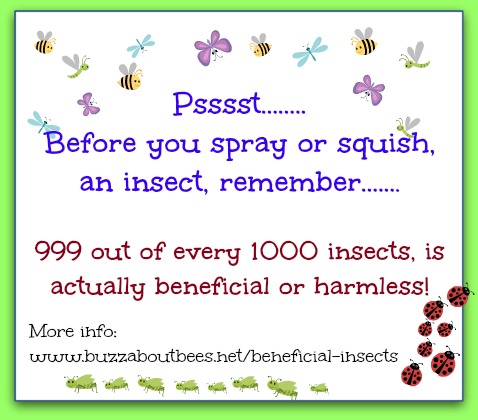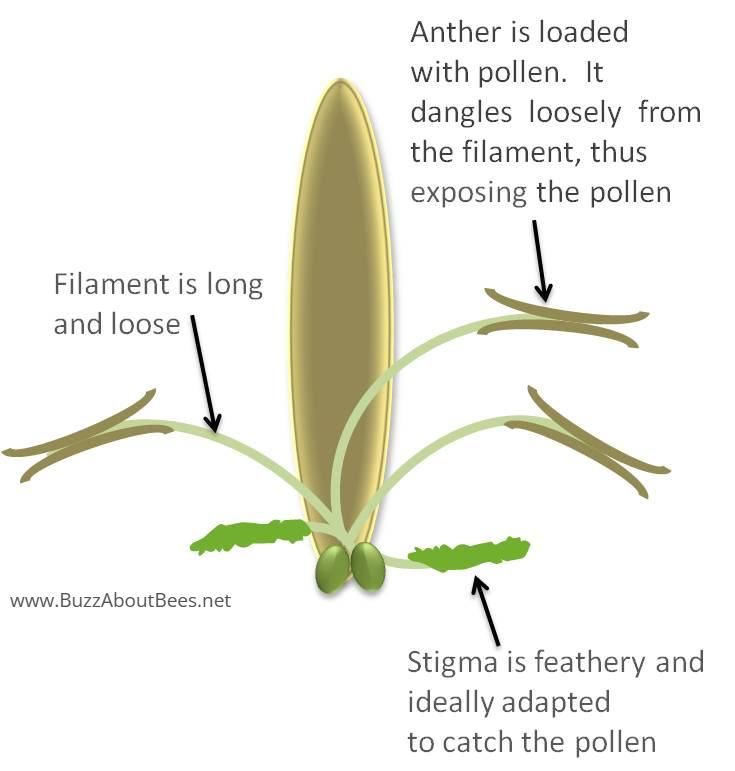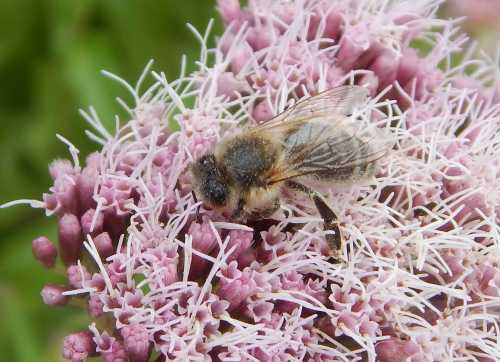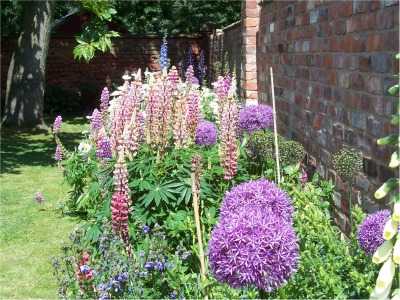Insect Pollination
Insect pollination is also known as ‘entomophily’, which describes the pollination process whereby pollen is transferred from one flower to another by insects.
Insects are vital not only to the ecosystem, but also to global food supply for humans. I have already written about bee pollination here.
Insect pollinators and pollination
Insect pollinators include:
- bees
- butterflies
- wasps
- moths
- many various flies, such as hover flies
- many various beetles.
How do insects pollinate flowers?
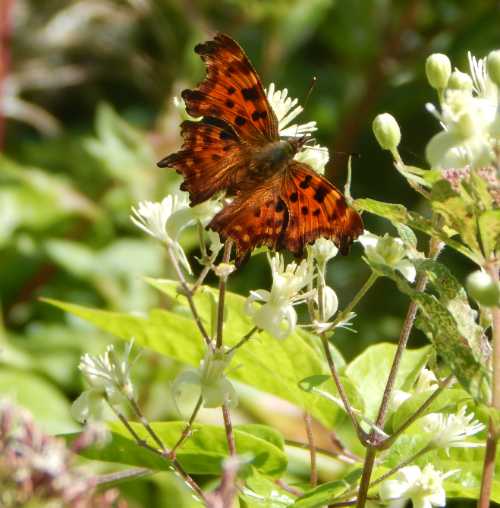 Comma butterfly
Comma butterfly
When visiting flowers, pollen sticks on to the body and legs of the insect. The pollen is then transferred from the male parts of a flower to female parts, enabling pollination to take place. Read more about the process of pollination.
How do plants attract pollinating insects?
Depending on insect species (or indeed bird or animal pollinators - bats and hummingbirds, for example, are known to pollinate flowers), plants have various characteristics that will attract the target pollinator. They are known as pollination syndromes. These may include:
- reward - such as nectar and pollen
- scent
- visual cues - colours and patterns
- shape
In my page about flower pollination, you can read more about how flowers are adapted to attract their ideal pollinators (pollination syndromes).
How Much Is Insect Pollination Worth?
It's clear that insect pollination is vital for landscape and habitat diversity. Many plants, flowers and trees depend on insects to create seeds and fruits (from apples to various wild hips, nuts and berries) upon which humans and wildlife depend.
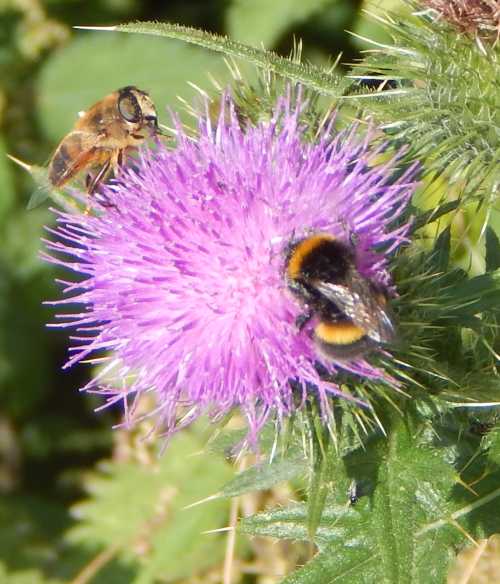 Hover fly and bumble bee on thistle
Hover fly and bumble bee on thistleHowever, when considering the value of insect pollination, usually it is only the economic benefit to humans that guide the calculations.
Attempts have been made to put a financial value on insect pollination, but ascribing a value is not easy. Various research reports have been published with findings as follows:
- 2012 study: Jordan et al1
"Economic Dependence and Vulnerability of United States Agricultural Sector on Insect-Mediated Pollination Service":
Finds:
"....economic dependence of United States crops on insect-mediated pollination service at the county level and update existing coefficients of insect dependence of sample crops when possible. Economic value dependent on pollination service totals 34.0 billion USD in 2012. "
- 2009 study: Gallai et al2
"Economic valuation of the vulnerability of world agriculture confronted to pollinator decline"
"The total economic value of pollination worldwide amounted to €153 billion, which represented 9.5% of the value of the world agricultural production used for human food in 2005."
Which insects are pollinating food crops, flowers and plants?
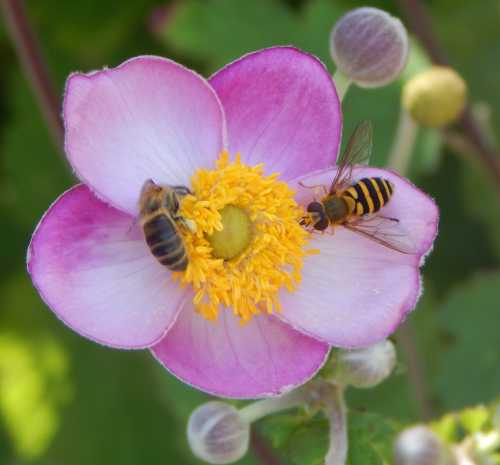 A honey bee (left) and a hover fly (right) forage on a Japanese anemone flower.
A honey bee (left) and a hover fly (right) forage on a Japanese anemone flower.Many insects play a role in pollinating crops, but also flowers, trees, shrubs and hedgerows.
Bees are the mostly widely understood pollinators, and honey bees have long received recognition for the pollination service they provide. Honey bees are essential for pollinating crops like almonds. Read more about honey bee pollination.
However, increasingly, wild bees are being studied. Some species such as leafcutters are now known to be very efficient pollinators of alfalfa, and mason bee species are helpful in orchards, whilst bumble bees are valued for their ability to increase tomato yields.
Still, the extent of the contribution from other insects is still not fully understood.
“…in Europe, a region better studied
than most, about 250 plant species are grown as crops. Of these, about
150 are thought to be insect pollinated, but for most we do not know
which insects pollinate them, or whether yields are being limited by
inadequate pollination". - “Bumblebees Behaviour and Ecology” by Professor Dave Goulson, citing Corbet et al 1991 & Williams 1995.
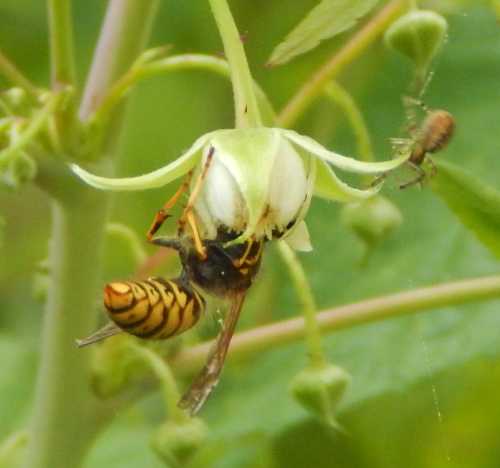 Wasp on a raspberry flower
Wasp on a raspberry flower
The Status And Decline of Insect Pollinators: Some Random Statistics
In Europe:
- It is estimated that 84% of EU crops (valued at £12.6 billion) and 80% of wildflowers rely on insect pollination. (source: Buglife)
- Across Europe 38% of bee and hoverfly species are in decline, and only 12% are increasing. (source: Buglife)
- 24% of Europe's bumble bees are believed to be facing extinction according to one report.
In the USA:
- 57 species of bees are on the Red List – these are species that are seriously endangered or believed extinct. (Source: Xerces)
- 58 butterflies & moths are also on the US Red List. (Source: Xerces).
In the UK:
- Two thirds of UK moth species are in long term decline. (source: Buglife)
- “Lost” (possibly extinct) insect species include (among others): Bordered gothic moth (Heliophobus reticulata marginosa); Orange upperwing moth (Jodia croceago); Brighton wainscot moth (Oria musculosa) (source: Buglife)
- Over 75% of the 59 UK butterflies are declining and 5 species have become extinct. (source: Butterfly Conservation)
- 3 species of bumble bee have become extinct, and of the remaining 24 species, 2 are critically endangered, and 10 are in very serious decline. This includes 5 species that were common in the 1980s. (source: Bumblebee Conservation Trust).
- See the list of bees on the UK BAP priority list.
3 Simple Ways To Help Insect Pollinators
- Increase habitat and food for insect pollinators, including in gardens.
- Cut out the insecticides, especially in gardens and public planting schemes.
- By helping bees we are likely, by default, to help other pollinators - here are 10 tips to help bees.
References
(1) Economic Dependence and Vulnerability of United States Agricultural Sector on Insect-Mediated Pollination Service; Environmental Science & Technology 2021 55 (4), 2243-2253; DOI: 10.1021/acs.est.0c04786.
(2) Economic valuation of the vulnerability of world agriculture confronted to pollinator decline; Gallai, Nicola & Salles, Jean-Michel & Settele, Josef & Vaissière, Bernard. (2009). . Ecological Economics. 68. 810-821. 10.1016/j.ecolecon.2008.06.014.
If you found this page helpful or interesting, I'd really be grateful if you would share it with others - if not this page, perhaps another, such as Gardening For Bees.
Thank you so much :) .
